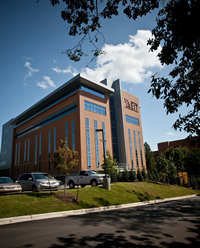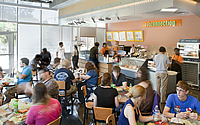EIT Building: ‘Most Advanced Anywhere’
UALR’s six-story, student-oriented and research-accommodating home to the Donaghey College of Engineering and Information Technology is part educational institution, part innovation incubator, and full-time economic engine providing Arkansas students and industry the knowledge and skills to compete in a global, technology-driven world.
 “It is the best example of current technology infrastructure you could find anywhere,” said EIT’s dean, Dr. Mary Good.
“It is the best example of current technology infrastructure you could find anywhere,” said EIT’s dean, Dr. Mary Good.
The new, environmentally friendly structure houses three departments in the constantly expanding college. The Donaghey college was established 11 years ago when visionaries on campus, the business community, and the Arkansas Legislature saw that a revolution in systems engineering, computer science, and information science driving innovation in the late 1990s would be a key to economic progress in the 21st century.
 At the building’s dedication on Sept. 10, Chancellor Joel E. Anderson unveiled four bronze plaques in the new building’s lobby honoring four key players in creating the college.
At the building’s dedication on Sept. 10, Chancellor Joel E. Anderson unveiled four bronze plaques in the new building’s lobby honoring four key players in creating the college.
Chancellor Emeritus Charles Hathaway, a scientist and pioneer of the metropolitan university movement who often quotes the mantra, “behind every great city is a great university,” worked with business and industry leaders to conceive the project. Arkansas Sen. Bob Johnson, speaker of the house in the late 1990s and a UALR alumnus, took up the cause in the legislature, pushing colleagues to provide start-up funds for the new college. Haskell Dickinson captured the imaginations of business and industry and led business leaders to see what such a college could do for central Arkansas. The final plaque honors Good.
“With a 21st century engineering college now in place, UALR makes central Arkansas a much more fertile place for high-tech businesses with high-paying jobs for the people of Arkansas,” Dr. Anderson said at the dedication. “I applaud Dean Mary Good and the faculty for the speed with which they have built the college.”
 See more photos on our Flickr page.
See more photos on our Flickr page.
Since it enrolled its first students in 2001, UALR has graduated 1,183 EIT students with degrees in information science, systems engineering, computer science, engineering technology, construction management, and applied science; created a nanotechnology research center; partnered with technology-focused companies like Acxiom, Southwest Power Pool, and Windstream; bolstered Arkansas’ bid for new wind energy jobs; and attracted world-class professors and researchers helping to push the envelope of engineering- and computer-based industries in Arkansas.
Planning for a home for EIT began with a $5 million appropriation by the 1999 Legislature, followed by nearly constant fundraising efforts by the University and industry supporters – including a $6 million gift from the Trinity Foundation, which allowed the expansion of the systems engineering program.
Construction on the new EIT Building began in July 2008 with plans to leave the auditorium and fourth floor unfinished, but when the Board of Trustees voted in September 2009 to approve a $34.1 million bond issue for other UALR construction needs, Anderson released $5.5 million to complete the building.
 The new EIT building is filled with features promoting creativity, collaboration, and innovation. Wide areas outside classrooms with comfortable lounge seating include whiteboards to promote collaboration; a dedicated double-sized capstone classroom provides room for robots to run and other projects to be constructed.
The new EIT building is filled with features promoting creativity, collaboration, and innovation. Wide areas outside classrooms with comfortable lounge seating include whiteboards to promote collaboration; a dedicated double-sized capstone classroom provides room for robots to run and other projects to be constructed.
A two-story, 206-seat auditorium provides state-of-the-art technology for conferences and meetings with an advanced audiovisual system and an electrical outlet and network port at each seat.
Three 44-workstation research bays provide dedicated space for EIT graduate students to conduct their research. Verizon Wireless donated furniture to outfit the research areas as part of their ongoing effort to support education initiatives within Arkansas.
The building includes 22 of 3M’s latest smart projectors that can physically project a professor’s notes or calculations, then saving them and providing the ability to email copies to lecture participants.
A distributed computing system has been installed, allowing software and operating systems to reside on servers in the data center. Instead of bulky CPU units crowding classrooms, only thin client units, monitors and keyboards take up space.
 With software and operating systems residing on servers in the building’s data center, students can access any workstation with their unique password. Each student has a “profile,” so that when he or she logs on, from anywhere on the network, the proper software will be available, as will access to all files.
With software and operating systems residing on servers in the building’s data center, students can access any workstation with their unique password. Each student has a “profile,” so that when he or she logs on, from anywhere on the network, the proper software will be available, as will access to all files.
Not only does the system save space, it saves money. The University doesn’t have to spend money for software licenses for each computer station since not all software will be used at the same time and scheduling classroom space will be more efficient.
Other highlights of the new building include:
- A high-performance computing cluster that when fully outfitted will be among the largest such centers at an academic institution in Arkansas and an adjacent research area with 13 cubicle work spaces.
- Twelve terraced classrooms, each including between 36 and 40 workstations for students, outfitted with a thin-client computing terminal, monitor, and keyboard.
- A 24-workstation student computer laboratory in the Student Services suite.
- Three server rooms, only one currently utilized, to handle future growth in the building’s technology infrastructure.
- A networking laboratory and wireless telecom laboratory
- A Sub Connection café by Sodexo with seating for 50-plus, including patio tables and a walk-up window.
A plaque on the sixth floor of the building identifies the Verizon Wireless Research Laboratory. The company’s gift of 145 Steel Case cubicle workstations has created mini-offices for graduate student researchers.
The birth of the Donaghey college and the construction of its new home is a crowing achievement for Good, the first woman to earn a Ph.D. in the hard sciences in Arkansas. A former president of the American Association for the Advancement of Science, Good is the recipient of Vannevar Bush Award, the National Science Foundation’s highest honor; the National Science Foundation Distinguished Service medal; the American Chemical Society Priestly Medal, and was the sixth annual Heinz Award Winner. Good, who served in scientific capacities in the administrations of three American presidents, announced earlier this year her intention to retire June 30, 2011.
“She came here 10 years ago … in a decision that I think will have very far-reaching, positive consequences for our state and for our entire country,” former President Bill Clinton said of Good at EIT’s 10th anniversary gala in November.